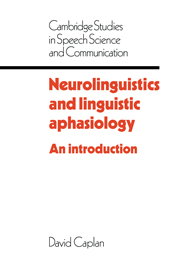Book contents
- Frontmatter
- Contents
- Preface
- Part I Introduction
- Part II Clinical aphasiology and neurolinguistics
- Part III Linguistic aphasiology
- 11 Linguistic descriptions and aphasic syndromes
- 12 Disturbances of lexical semantic representation
- 13 Disturbances of the sound system
- 14 Acquired dyslexia
- 15 Disturbances of sentence production: agrammatism
- 16 Disturbances of sentence comprehension
- 17 Overview of linguistic aphasiology
- Part IV Contemporary neurolinguistics
- References
- Author index
- Subject index
17 - Overview of linguistic aphasiology
Published online by Cambridge University Press: 10 December 2009
- Frontmatter
- Contents
- Preface
- Part I Introduction
- Part II Clinical aphasiology and neurolinguistics
- Part III Linguistic aphasiology
- 11 Linguistic descriptions and aphasic syndromes
- 12 Disturbances of lexical semantic representation
- 13 Disturbances of the sound system
- 14 Acquired dyslexia
- 15 Disturbances of sentence production: agrammatism
- 16 Disturbances of sentence comprehension
- 17 Overview of linguistic aphasiology
- Part IV Contemporary neurolinguistics
- References
- Author index
- Subject index
Summary
We have covered a great deal of material in Chapters 11–16, and we shall take this opportunity to review some of the most important features of the work we have discussed, to relate this work to the material we covered in Part II, and to discuss a number of directions that work in linguistic aphasiology may take in the future.
Perhaps the first major feature of the research that we have been discussing is that it relates to a relatively new domain of investigation – linguistic aphasiology. Though it has implications for neurolinguistics (and we shall discuss some of these implïcations in Chapters 19 and 23), linguistic aphasiology is not neurolinguistics. Nor is it purely psycholinguistics or theoretical linguistics. Linguistic, psycholinguistic, and cognitive psychological concepts are applied to aphasia by linguistic aphasiologists to describe the phenomena of disturbed language processing and related cognitive impairments. As we have seen, this process can be carried out with little or no reference to the neurological basis for cognition or language, or to the neuropathological determinants of functional abnormalities in these spheres. Similarly, though linguistic aphasiology does seek to describe aphasic impairments in terms of deficits in sub-components of a language-processing system and related cognitive capacities, linguistic aphasiology is also separate from normal studies. This is partly because brain-injured subjects are often quite impaired with respect to their ability to process language normally, and therefore studying aphasic patients often does not lead to a consideration of the full range of linguistic structures or psycholinguistic processes that normals are capable of. For this reason alone, linguistic aphasiology is in some ways more limited than the study of normal language and its processing.
- Type
- Chapter
- Information
- Neurolinguistics and Linguistic AphasiologyAn Introduction, pp. 328 - 342Publisher: Cambridge University PressPrint publication year: 1987

